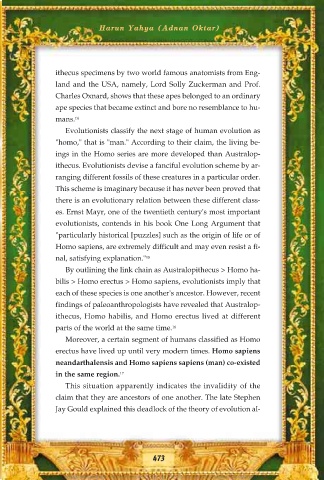Page 475 - Pleasant Words from the Gospe
P. 475
Harun Yahya (Adnan Oktar)
ithecus specimens by two world famous anatomists from Eng-
land and the USA, namely, Lord Solly Zuckerman and Prof.
Charles Oxnard, shows that these apes belonged to an ordinary
ape species that became extinct and bore no resemblance to hu-
mans. 14
Evolutionists classify the next stage of human evolution as
"homo," that is "man." According to their claim, the living be-
ings in the Homo series are more developed than Australop-
ithecus. Evolutionists devise a fanciful evolution scheme by ar-
ranging different fossils of these creatures in a particular order.
This scheme is imaginary because it has never been proved that
there is an evolutionary relation between these different class-
es. Ernst Mayr, one of the twentieth century's most important
evolutionists, contends in his book One Long Argument that
"particularly historical [puzzles] such as the origin of life or of
Homo sapiens, are extremely difficult and may even resist a fi-
nal, satisfying explanation." 15
By outlining the link chain as Australopithecus > Homo ha-
bilis > Homo erectus > Homo sapiens, evolutionists imply that
each of these species is one another's ancestor. However, recent
findings of paleoanthropologists have revealed that Australop-
ithecus, Homo habilis, and Homo erectus lived at different
parts of the world at the same time. 16
Moreover, a certain segment of humans classified as Homo
erectus have lived up until very modern times. Homo sapiens
neandarthalensis and Homo sapiens sapiens (man) co-existed
in the same region. 17
This situation apparently indicates the invalidity of the
claim that they are ancestors of one another. The late Stephen
Jay Gould explained this deadlock of the theory of evolution al-
473

